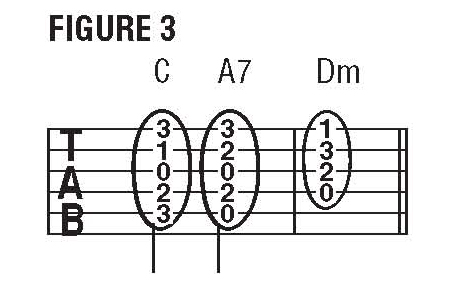Hole Notes: Take This Pair Of Strings And Learn To Fly

Examining Paul McCartney’s “two-finger” magic in “Blackbird.”
The Beatles’ “Blackbird,” performed entirely by Paul McCartney using his Martin D-28, was released on the 1968 album The Beatles (commonly referred to as the White Album). From a guitar standpoint, the song’s roots and inspiration can be traced back to McCartney’s early experimentation with a well-known piece by J.S. Bach titled “Bourée in E Minor,” which he woodshedded in his youth. (Lyrically, “Blackbird” was penned in reaction to escalating racial tensions in the U.S. in the late Sixties.) To this day, guitar teachers find that the tune is one of the most commonly requested songs among their fledgling fingerstyle students. Let’s examine what makes this classic track tick.

Throughout “Blackbird,” McCartney uses his pick-hand thumb (p) and index finger (i) to sound strings, while fretting only two notes (mostly on the A and B strings), plucking the open G string on the eighth-note upbeats. For the basics of this technique, have a look at FIGURE 1. As indicated, pluck the first two notes simultaneously with your pick-hand thumb and index finger. These two notes, along with the open G string, imply a C chord (C E G). As the figure unfolds, this shape, fretted with the same two fingers, is shifted up the neck, with the notes’ spacing modified slightly to accommodate notes in the C major scale (C D E F G A B). Pluck the open G string in between each shifted shape with your thumb.

Additionally, in “Blackbird” McCartney plucks passages like the one shown in FIGURE 2. In this “busier” groove, as your thumb alternates between the A and G strings, your pick-hand’s index finger strikes notes on the B string between thumb-picked notes.

Now let’s look at how these kinds of moveable two-note shapes can imply a chord progression. In the following examples, we’ll extract two notes at a time from stock chord shapes you’re likely already familiar with, such as those shown in FIGURE 3. Next, we’ll play these note pairs (on the A and B strings, exclusively) at different spots on the neck, plucking them McCartney style.

To illustrate, in FIGURE 4a three different pairs of chord tones from C (C E G) are fretted along these two strings, plucked in conjunction with the open G. Use your index finger and pinkie to fret all the notes. A7 (A C# E G) gets a similar treatment in FIGURE 4b. Notice that this chord has four different notes in it, yielding an extra shape at the end of the example: G (fifth string, 10th fret) and A (second string, 10th fret), fretted with the ring finger and pinkie, respectively. For Dm (D F A), locate the chord tones on the fifth and second strings and then pluck the three resultant shapes illustrated in FIGURE 4C.

FIGURE 5 illustrates this approach in an expanded progression that incorporates a variety of chords. Notice the new shapes, involving notes on the first string. For these, fret the fifth- and first-string notes with your middle and index fingers, respectively. The passage ends with an interesting C voicing, the result of shifting a common open G chord shape five frets up the neck, to C.
All the latest guitar news, interviews, lessons, reviews, deals and more, direct to your inbox!
